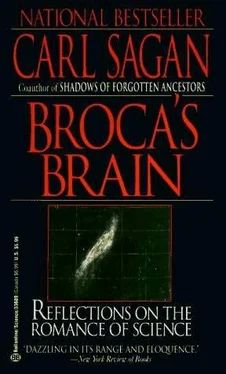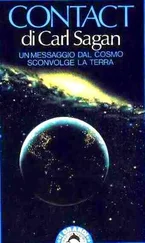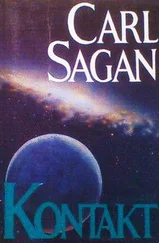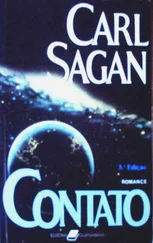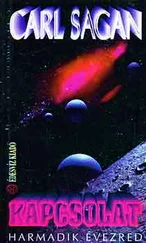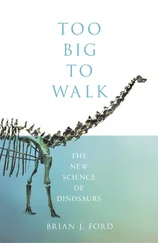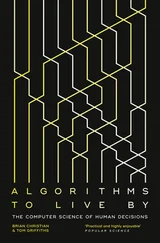Carl Sagan - Broca's Brain - The Romance of Science
Здесь есть возможность читать онлайн «Carl Sagan - Broca's Brain - The Romance of Science» весь текст электронной книги совершенно бесплатно (целиком полную версию без сокращений). В некоторых случаях можно слушать аудио, скачать через торрент в формате fb2 и присутствует краткое содержание. Жанр: Физика, на английском языке. Описание произведения, (предисловие) а так же отзывы посетителей доступны на портале библиотеки ЛибКат.
- Название:Broca's Brain: The Romance of Science
- Автор:
- Жанр:
- Год:неизвестен
- ISBN:нет данных
- Рейтинг книги:3 / 5. Голосов: 1
-
Избранное:Добавить в избранное
- Отзывы:
-
Ваша оценка:
- 60
- 1
- 2
- 3
- 4
- 5
Broca's Brain: The Romance of Science: краткое содержание, описание и аннотация
Предлагаем к чтению аннотацию, описание, краткое содержание или предисловие (зависит от того, что написал сам автор книги «Broca's Brain: The Romance of Science»). Если вы не нашли необходимую информацию о книге — напишите в комментариях, мы постараемся отыскать её.
Broca's Brain: The Romance of Science — читать онлайн бесплатно полную книгу (весь текст) целиком
Ниже представлен текст книги, разбитый по страницам. Система сохранения места последней прочитанной страницы, позволяет с удобством читать онлайн бесплатно книгу «Broca's Brain: The Romance of Science», без необходимости каждый раз заново искать на чём Вы остановились. Поставьте закладку, и сможете в любой момент перейти на страницу, на которой закончили чтение.
Интервал:
Закладка:
Many asteroids have orbits that are highly elliptical or stretched-out, not at all like the almost perfectly circular orbits of Earth or Venus. Some asteroids have their far points from the Sun beyond the orbit of Saturn; some have their near points to the Sun close to the orbit of Mercury; some, like 1685 Toro, live out their days between the orbits of Earth and Venus. Since there are so many asteroids on very elliptical orbits, collisions are inevitable over the lifetime of the solar system. Most collisions will be of the overtaking variety, one asteroid nudging up to another, making a soft splintering crash. Since the asteroids are so small, their gravity is low and the collision fragments will be splayed out into space into slightly different orbits from those of the parent asteroids. It can be calculated that such collisions will produce, on occasion, fragments that by accident intercept the Earth, fall through its atmosphere, survive the ablation of entry, and land at the feet of a quite properly astonished itinerant tribesman.
The few meteorites that have been tracked as they enter the Earth’s atmosphere originated back in the main asteroid belt, between Mars and Jupiter. Laboratory studies of the physical properties of some meteorites show them to have originated where the temperatures are those of the main asteroid belt. The evidence is clear: the meteorites ensconced in our museums are fragments of asteroids. We have on our shelves pieces of cosmic objects!
But which meteorites come from which asteroids? Until the last few years, answering this question was beyond the powers of planetary scientists. Recently, however, it has become possible to perform spectrophotometry of asteroids in visible and near-infrared radiation; to examine the polarization of sunlight reflected off asteroids as the geometry of the asteroid, the Sun and Earth changes; and to examine the middle-infrared emission of the asteroids. These asteroid observations, and comparable studies of meteorites and other minerals in the laboratory, have provided the first fascinating hints on the correlation between specific asteroids and specific meteorites. More than 90 percent of the asteroids studied fall into one of two composition groups: stony-iron or carbonaceous. Only a few percent of the meteorites on Earth are carbonaceous, but carbonaceous meteorites are very friable and rapidly weather to powder under typical terrestrial conditions. They probably also fragment more readily upon entry into the Earth’s atmosphere. Since stony-iron meteorites are much hardier, they are disproportionately represented in our museum collections of meteorites. The carbonaceous meteorites are rich in organic compounds, including amino acids (the building blocks of proteins), and may be representative of the materials from which the solar system was formed some 4.6 billion years ago.
Among the asteroids which appear to be carbonaceous are 1 Ceres, 2 Pallas, 19 Fortuna, 324 Bamberga and 654 Zelinda. If asteroids that are carbonaceous on the outside are also carbonaceous on the inside, then most of the asteroidal material is carbonaceous. They are generally dark objects, reflecting only a small percent of the light shining on them. Recent evidence suggests that Phobos and Deimos, the two moons of Mars, may also be carbonaceous, and are perhaps carbonaceous asteroids that have been captured by Martian gravity.
Typical asteroids showing properties of stony-iron meteorites are 3 Juno, 8 Flora, 12 Victoria, 89 Julia and 433 Eros. Several asteroids fit into some other category: 4 Vesta resembles a kind of meteorite called a basaltic achondrite, while 16 Psyche and 22 Kalliope appear to be largely iron.
The iron asteroids are interesting because geophysicists believe that the parent body of an object greatly enriched in iron must have been molten so as to differentiate, to separate out the iron from the silicates in the initial chaotic jumble of the elements in primordial times. On the other hand, for the organic molecules in carbonaceous meteorites to have survived at all they must never have been raised to temperatures hot enough to melt rock or iron. Thus, different histories are implied for different asteroids.
From the comparison of asteroidal and meteoritic properties, from laboratory studies of meteorites and computer projections back in time of asteroidal motions, it may one day be possible to reconstruct asteroid histories. Today we do not even know whether they represent a planet that was prevented from forming because of the powerful gravitational perturbations of nearby Jupiter, or whether they are the remnants of a fully formed planet that somehow exploded. Most students of the subject incline to the former hypothesis because no one can figure out how to blow up a planet-which is just as well. Eventually we may be able to piece together the whole story.
There may also be in hand meteorites which do not come from asteroids. Perhaps there are fragments of young comets, or of the moons of Mars, or of the surface of Mercury, or of the satellites of Jupiter, sitting dusty and ignored in some obscure museum. But it is clear that the true picture of the origin of the meteorites is beginning to emerge.
The Holy of Holies in the Temple of Diana at Ephesus has been destroyed. But the Kaaba has been carefully preserved, although there seems never to have been a true scientific examination of it. There are some who believe it to be a dark, stony rather than metallic meteorite. Recently two geologists have suggested, on admittedly quite fragmentary evidence, that it is instead an agate. Some Muslim writers believe that the color of the Kaaba was originally white, not black, and that the present color is due to its repeated handling. The official view of the Keeper of the Black Stone is that it was placed in its present position by the patriarch Abraham and fell from a religious rather than an astronomical heaven-so that no conceivable physical test of the object could be a test of Islamic doctrine. It would nevertheless be of great interest to examine, with the full armory of modern laboratory techniques, a small fragment of the Kaaba. Its composition could be determined with precision. If it is a meteorite, its cosmic-ray-exposure age-the time spent from fragmentation to arrival on Earth-could be established. And it would be possible to test hypotheses of origin: such as, for example, the idea that some 5 million years ago, about the time of the origin of the horninids, the Kaaba was chipped off an asteroid named 22 Kalliope, orbited the Sun for ages of geological time, and then accidentally encountered the Arabian Peninsula 2,500 years ago.
CHAPTER 16

The unquiet republic of the maze
Of Planets, struggling fierce towards heaven’s free
wilderness.
PERCY BYSSHE SHELLEY,
Prometheus Unbound (1820)
MUCH OF HUMAN HISTORY can, I think, be described as a gradual and sometimes painful liberation from provincialism, the emerging awareness that there is more to the world than was generally believed by our ancestors. With awesome ethnocentrism, tribes all over the Earth called themselves “the people” or “all men,” relegating other groups of humans with comparable accomplishments to subhuman status. The high civilization of ancient Greece divided the human community into Hellenes and barbarians, the latter named after an uncharitable imitation of the languages of non-Greeks (“Bar Bar…”). That same classical civilization, which in so many respects is the antecedent of our own, called its small inland sea the Mediterranean-which means the middle of the Earth. For thousands of years China called itself the Middle Kingdom, and the meaning was the same: China was at the center of the universe and the barbarians lived in outer darkness.
Читать дальшеИнтервал:
Закладка:
Похожие книги на «Broca's Brain: The Romance of Science»
Представляем Вашему вниманию похожие книги на «Broca's Brain: The Romance of Science» списком для выбора. Мы отобрали схожую по названию и смыслу литературу в надежде предоставить читателям больше вариантов отыскать новые, интересные, ещё непрочитанные произведения.
Обсуждение, отзывы о книге «Broca's Brain: The Romance of Science» и просто собственные мнения читателей. Оставьте ваши комментарии, напишите, что Вы думаете о произведении, его смысле или главных героях. Укажите что конкретно понравилось, а что нет, и почему Вы так считаете.
